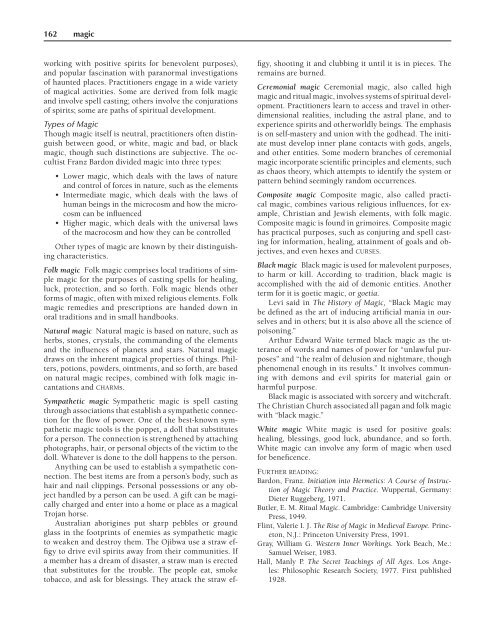The Encyclopedia Of Demons And Demonology
The Encyclopedia Of Demons And Demonology
The Encyclopedia Of Demons And Demonology
You also want an ePaper? Increase the reach of your titles
YUMPU automatically turns print PDFs into web optimized ePapers that Google loves.
162 magic<br />
working with positive spirits for benevolent purposes),<br />
and popular fascination with paranormal investigations<br />
of haunted places. Practitioners engage in a wide variety<br />
of magical activities. Some are derived from folk magic<br />
and involve spell casting; others involve the conjurations<br />
of spirits; some are paths of spiritual development.<br />
Types of Magic<br />
Though magic itself is neutral, practitioners often distinguish<br />
between good, or white, magic and bad, or black<br />
magic, though such distinctions are subjective. <strong>The</strong> occultist<br />
Franz Bardon divided magic into three types:<br />
• Lower magic, which deals with the laws of nature<br />
and control of forces in nature, such as the elements<br />
• Intermediate magic, which deals with the laws of<br />
human beings in the microcosm and how the microcosm<br />
can be influenced<br />
• Higher magic, which deals with the universal laws<br />
of the macrocosm and how they can be controlled<br />
Other types of magic are known by their distinguishing<br />
characteristics.<br />
Folk magic Folk magic comprises local traditions of simple<br />
magic for the purposes of casting spells for healing,<br />
luck, protection, and so forth. Folk magic blends other<br />
forms of magic, often with mixed religious elements. Folk<br />
magic remedies and prescriptions are handed down in<br />
oral traditions and in small handbooks.<br />
Natural magic Natural magic is based on nature, such as<br />
herbs, stones, crystals, the commanding of the elements<br />
and the influences of planets and stars. Natural magic<br />
draws on the inherent magical properties of things. Philters,<br />
potions, powders, ointments, and so forth, are based<br />
on natural magic recipes, combined with folk magic incantations<br />
and CHARMs.<br />
Sympathetic magic Sympathetic magic is spell casting<br />
through associations that establish a sympathetic connection<br />
for the flow of power. One of the best-known sympathetic<br />
magic tools is the poppet, a doll that substitutes<br />
for a person. <strong>The</strong> connection is strengthened by attaching<br />
photographs, hair, or personal objects of the victim to the<br />
doll. Whatever is done to the doll happens to the person.<br />
Anything can be used to establish a sympathetic connection.<br />
<strong>The</strong> best items are from a person’s body, such as<br />
hair and nail clippings. Personal possessions or any object<br />
handled by a person can be used. A gift can be magically<br />
charged and enter into a home or place as a magical<br />
Trojan horse.<br />
Australian aborigines put sharp pebbles or ground<br />
glass in the footprints of enemies as sympathetic magic<br />
to weaken and destroy them. <strong>The</strong> Ojibwa use a straw effigy<br />
to drive evil spirits away from their communities. If<br />
a member has a dream of disaster, a straw man is erected<br />
that substitutes for the trouble. <strong>The</strong> people eat, smoke<br />
tobacco, and ask for blessings. <strong>The</strong>y attack the straw effigy,<br />
shooting it and clubbing it until it is in pieces. <strong>The</strong><br />
remains are burned.<br />
Ceremonial magic Ceremonial magic, also called high<br />
magic and ritual magic, involves systems of spiritual development.<br />
Practitioners learn to access and travel in otherdimensional<br />
realities, including the astral plane, and to<br />
experience spirits and otherworldly beings. <strong>The</strong> emphasis<br />
is on self-mastery and union with the godhead. <strong>The</strong> initiate<br />
must develop inner plane contacts with gods, angels,<br />
and other entities. Some modern branches of ceremonial<br />
magic incorporate scientific principles and elements, such<br />
as chaos theory, which attempts to identify the system or<br />
pattern behind seemingly random occurrences.<br />
Composite magic Composite magic, also called practical<br />
magic, combines various religious influences, for example,<br />
Christian and Jewish elements, with folk magic.<br />
Composite magic is found in grimoires. Composite magic<br />
has practical purposes, such as conjuring and spell casting<br />
for information, healing, attainment of goals and objectives,<br />
and even hexes and CURSES.<br />
Black magic Black magic is used for malevolent purposes,<br />
to harm or kill. According to tradition, black magic is<br />
accomplished with the aid of demonic entities. Another<br />
term for it is goetic magic, or goetia.<br />
Levi said in <strong>The</strong> History of Magic, “Black Magic may<br />
be defined as the art of inducing artificial mania in ourselves<br />
and in others; but it is also above all the science of<br />
poisoning.”<br />
Arthur Edward Waite termed black magic as the utterance<br />
of words and names of power for “unlawful purposes”<br />
and “the realm of delusion and nightmare, though<br />
phenomenal enough in its results.” It involves communing<br />
with demons and evil spirits for material gain or<br />
harmful purpose.<br />
Black magic is associated with sorcery and witchcraft.<br />
<strong>The</strong> Christian Church associated all pagan and folk magic<br />
with “black magic.”<br />
White magic White magic is used for positive goals:<br />
healing, blessings, good luck, abundance, and so forth.<br />
White magic can involve any form of magic when used<br />
for beneficence.<br />
FURTHER READING:<br />
Bardon, Franz. Initiation into Hermetics: A Course of Instruction<br />
of Magic <strong>The</strong>ory and Practice. Wuppertal, Germany:<br />
Dieter Ruggeberg, 1971.<br />
Butler, E. M. Ritual Magic. Cambridge: Cambridge University<br />
Press, 1949.<br />
Flint, Valerie I. J. <strong>The</strong> Rise of Magic in Medieval Europe. Princeton,<br />
N.J.: Princeton University Press, 1991.<br />
Gray, William G. Western Inner Workings. York Beach, Me.:<br />
Samuel Weiser, 1983.<br />
Hall, Manly P. <strong>The</strong> Secret Teachings of All Ages. Los Angeles:<br />
Philosophic Research Society, 1977. First published<br />
1928.












